Analyzing Innovation and Continuous Improvement in Business
VerifiedAdded on 2023/06/11
|27
|6031
|96
Report
AI Summary
This report provides a comprehensive analysis of innovation and continuous improvement strategies within a business context. It explores various methods for analyzing and evaluating performance and sustainability, including benchmarking, interviews, social media monitoring, and financial analysis. The report outlines the stages of supply chain management, performance measurement methods, and analytical steps for addressing variations from plans. It also discusses the role of digital specialists, continuous improvement strategies like Lean technology and Six Sigma, and methods for inspiring and rewarding new ideas. Furthermore, the document covers risk assessment steps, innovation approval processes, and the implementation of Lean manufacturing. The report concludes with an examination of the cost-benefit analysis, innovation approaches, and the importance of open communication for team interaction. Desklib offers this and many other student-contributed documents to aid in your studies.
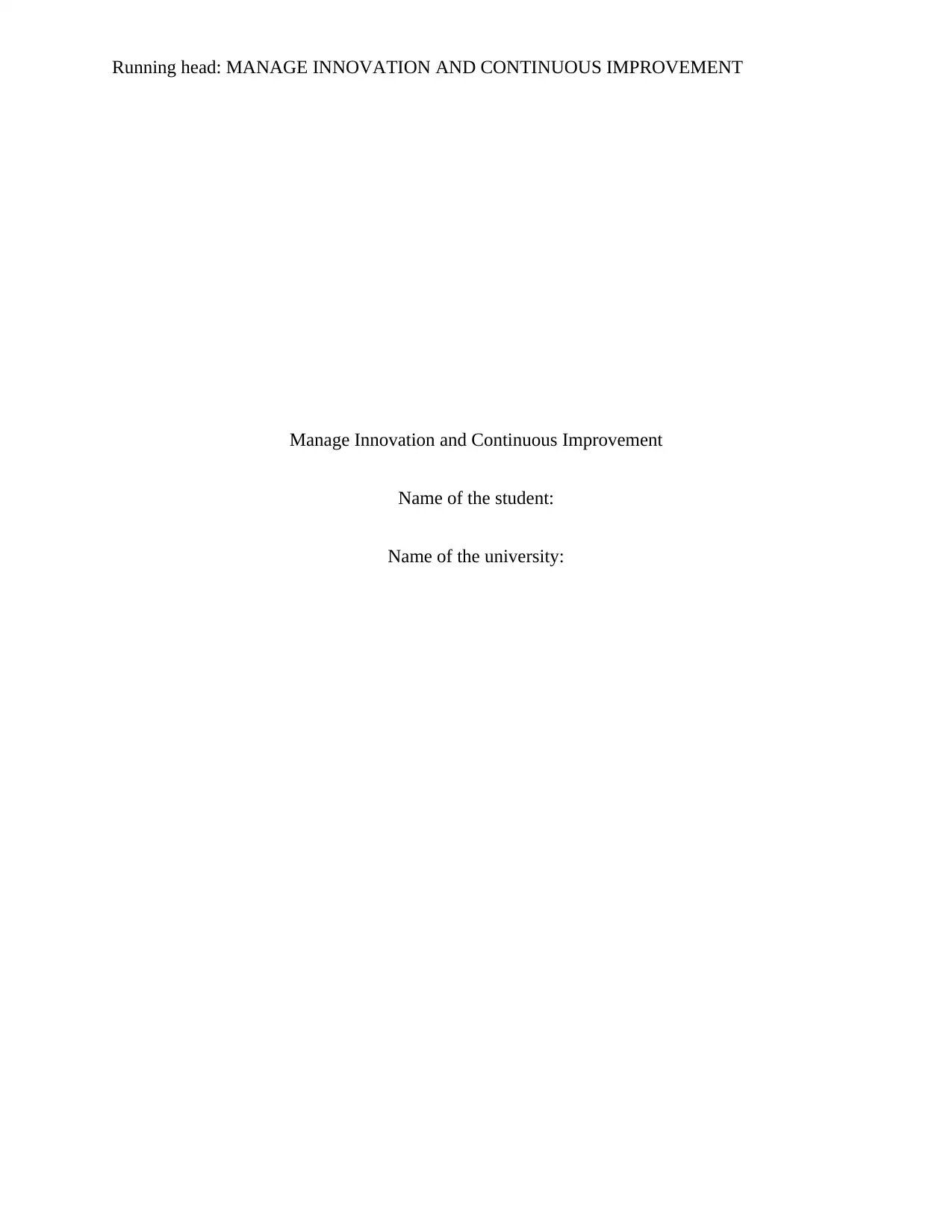
Running head: MANAGE INNOVATION AND CONTINUOUS IMPROVEMENT
Manage Innovation and Continuous Improvement
Name of the student:
Name of the university:
Manage Innovation and Continuous Improvement
Name of the student:
Name of the university:
Paraphrase This Document
Need a fresh take? Get an instant paraphrase of this document with our AI Paraphraser
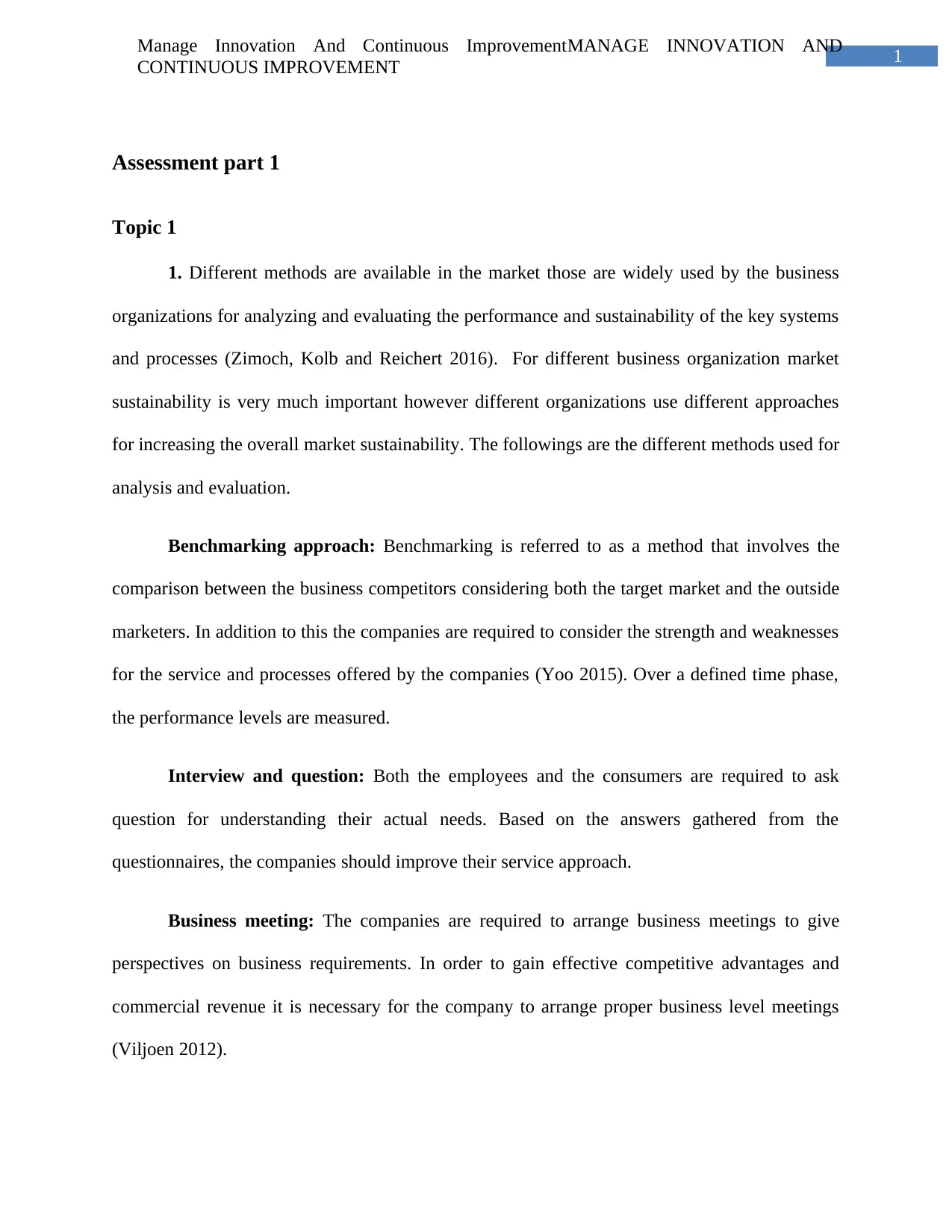
1
Manage Innovation And Continuous ImprovementMANAGE INNOVATION AND
CONTINUOUS IMPROVEMENT
Assessment part 1
Topic 1
1. Different methods are available in the market those are widely used by the business
organizations for analyzing and evaluating the performance and sustainability of the key systems
and processes (Zimoch, Kolb and Reichert 2016). For different business organization market
sustainability is very much important however different organizations use different approaches
for increasing the overall market sustainability. The followings are the different methods used for
analysis and evaluation.
Benchmarking approach: Benchmarking is referred to as a method that involves the
comparison between the business competitors considering both the target market and the outside
marketers. In addition to this the companies are required to consider the strength and weaknesses
for the service and processes offered by the companies (Yoo 2015). Over a defined time phase,
the performance levels are measured.
Interview and question: Both the employees and the consumers are required to ask
question for understanding their actual needs. Based on the answers gathered from the
questionnaires, the companies should improve their service approach.
Business meeting: The companies are required to arrange business meetings to give
perspectives on business requirements. In order to gain effective competitive advantages and
commercial revenue it is necessary for the company to arrange proper business level meetings
(Viljoen 2012).
Manage Innovation And Continuous ImprovementMANAGE INNOVATION AND
CONTINUOUS IMPROVEMENT
Assessment part 1
Topic 1
1. Different methods are available in the market those are widely used by the business
organizations for analyzing and evaluating the performance and sustainability of the key systems
and processes (Zimoch, Kolb and Reichert 2016). For different business organization market
sustainability is very much important however different organizations use different approaches
for increasing the overall market sustainability. The followings are the different methods used for
analysis and evaluation.
Benchmarking approach: Benchmarking is referred to as a method that involves the
comparison between the business competitors considering both the target market and the outside
marketers. In addition to this the companies are required to consider the strength and weaknesses
for the service and processes offered by the companies (Yoo 2015). Over a defined time phase,
the performance levels are measured.
Interview and question: Both the employees and the consumers are required to ask
question for understanding their actual needs. Based on the answers gathered from the
questionnaires, the companies should improve their service approach.
Business meeting: The companies are required to arrange business meetings to give
perspectives on business requirements. In order to gain effective competitive advantages and
commercial revenue it is necessary for the company to arrange proper business level meetings
(Viljoen 2012).
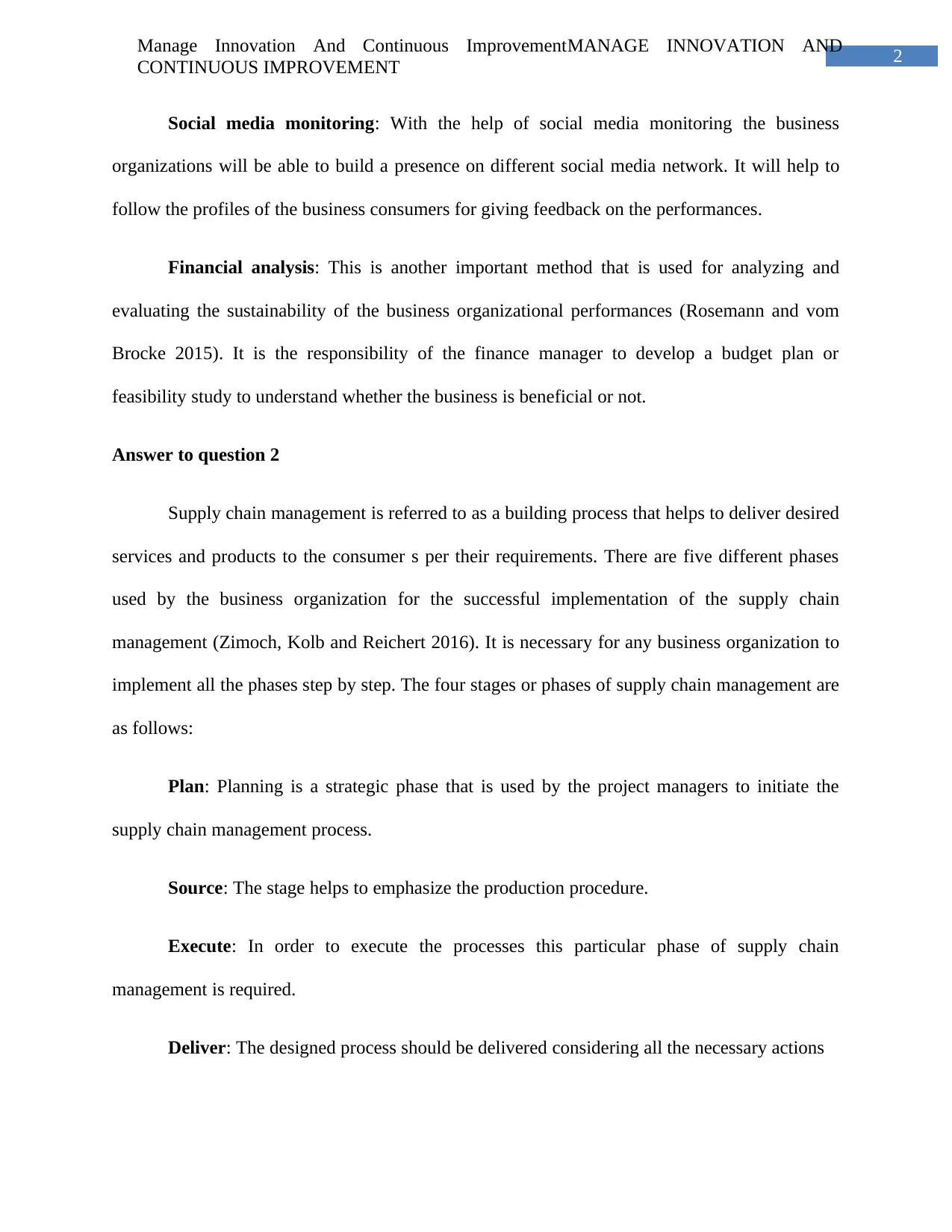
2
Manage Innovation And Continuous ImprovementMANAGE INNOVATION AND
CONTINUOUS IMPROVEMENT
Social media monitoring: With the help of social media monitoring the business
organizations will be able to build a presence on different social media network. It will help to
follow the profiles of the business consumers for giving feedback on the performances.
Financial analysis: This is another important method that is used for analyzing and
evaluating the sustainability of the business organizational performances (Rosemann and vom
Brocke 2015). It is the responsibility of the finance manager to develop a budget plan or
feasibility study to understand whether the business is beneficial or not.
Answer to question 2
Supply chain management is referred to as a building process that helps to deliver desired
services and products to the consumer s per their requirements. There are five different phases
used by the business organization for the successful implementation of the supply chain
management (Zimoch, Kolb and Reichert 2016). It is necessary for any business organization to
implement all the phases step by step. The four stages or phases of supply chain management are
as follows:
Plan: Planning is a strategic phase that is used by the project managers to initiate the
supply chain management process.
Source: The stage helps to emphasize the production procedure.
Execute: In order to execute the processes this particular phase of supply chain
management is required.
Deliver: The designed process should be delivered considering all the necessary actions
Manage Innovation And Continuous ImprovementMANAGE INNOVATION AND
CONTINUOUS IMPROVEMENT
Social media monitoring: With the help of social media monitoring the business
organizations will be able to build a presence on different social media network. It will help to
follow the profiles of the business consumers for giving feedback on the performances.
Financial analysis: This is another important method that is used for analyzing and
evaluating the sustainability of the business organizational performances (Rosemann and vom
Brocke 2015). It is the responsibility of the finance manager to develop a budget plan or
feasibility study to understand whether the business is beneficial or not.
Answer to question 2
Supply chain management is referred to as a building process that helps to deliver desired
services and products to the consumer s per their requirements. There are five different phases
used by the business organization for the successful implementation of the supply chain
management (Zimoch, Kolb and Reichert 2016). It is necessary for any business organization to
implement all the phases step by step. The four stages or phases of supply chain management are
as follows:
Plan: Planning is a strategic phase that is used by the project managers to initiate the
supply chain management process.
Source: The stage helps to emphasize the production procedure.
Execute: In order to execute the processes this particular phase of supply chain
management is required.
Deliver: The designed process should be delivered considering all the necessary actions
⊘ This is a preview!⊘
Do you want full access?
Subscribe today to unlock all pages.

Trusted by 1+ million students worldwide
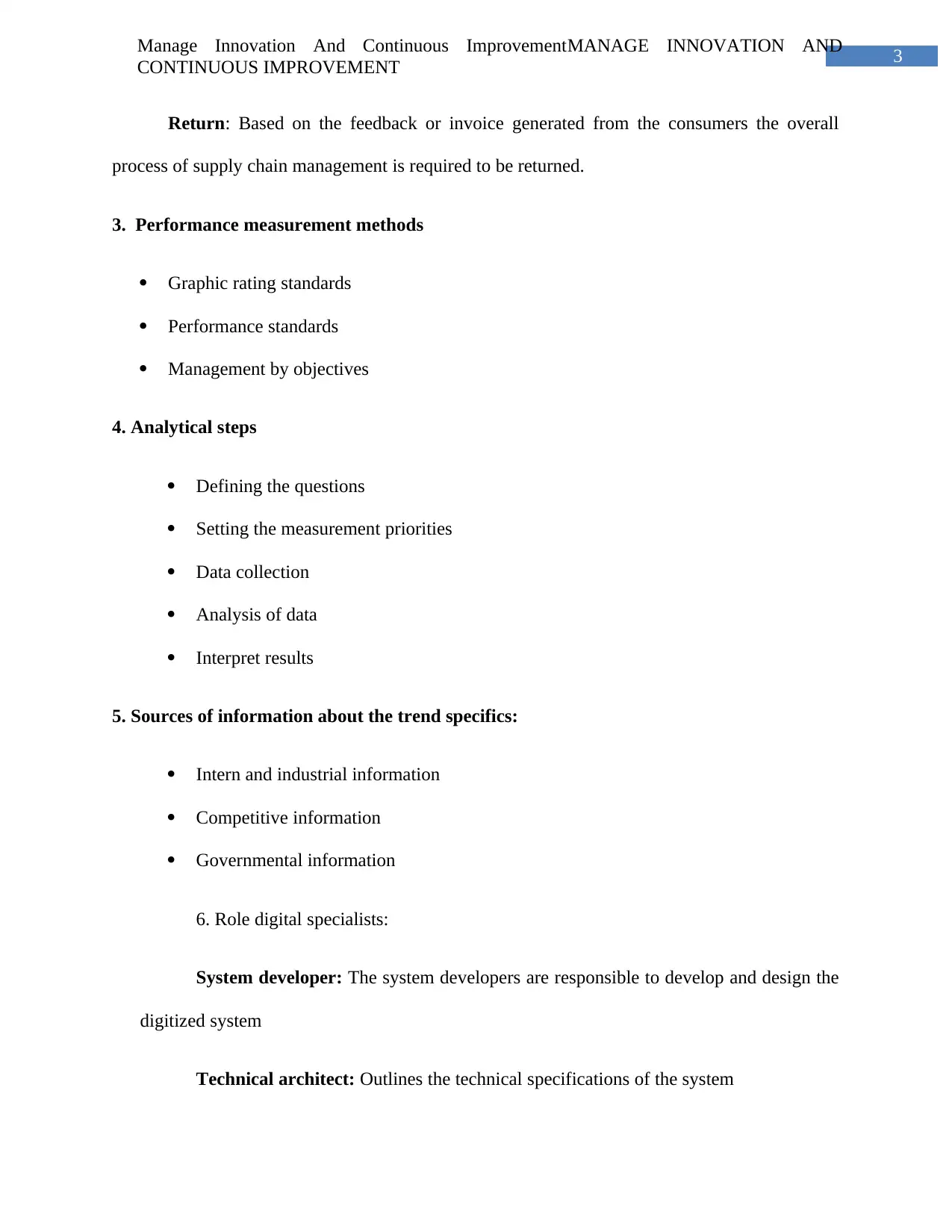
3
Manage Innovation And Continuous ImprovementMANAGE INNOVATION AND
CONTINUOUS IMPROVEMENT
Return: Based on the feedback or invoice generated from the consumers the overall
process of supply chain management is required to be returned.
3. Performance measurement methods
Graphic rating standards
Performance standards
Management by objectives
4. Analytical steps
Defining the questions
Setting the measurement priorities
Data collection
Analysis of data
Interpret results
5. Sources of information about the trend specifics:
Intern and industrial information
Competitive information
Governmental information
6. Role digital specialists:
System developer: The system developers are responsible to develop and design the
digitized system
Technical architect: Outlines the technical specifications of the system
Manage Innovation And Continuous ImprovementMANAGE INNOVATION AND
CONTINUOUS IMPROVEMENT
Return: Based on the feedback or invoice generated from the consumers the overall
process of supply chain management is required to be returned.
3. Performance measurement methods
Graphic rating standards
Performance standards
Management by objectives
4. Analytical steps
Defining the questions
Setting the measurement priorities
Data collection
Analysis of data
Interpret results
5. Sources of information about the trend specifics:
Intern and industrial information
Competitive information
Governmental information
6. Role digital specialists:
System developer: The system developers are responsible to develop and design the
digitized system
Technical architect: Outlines the technical specifications of the system
Paraphrase This Document
Need a fresh take? Get an instant paraphrase of this document with our AI Paraphraser
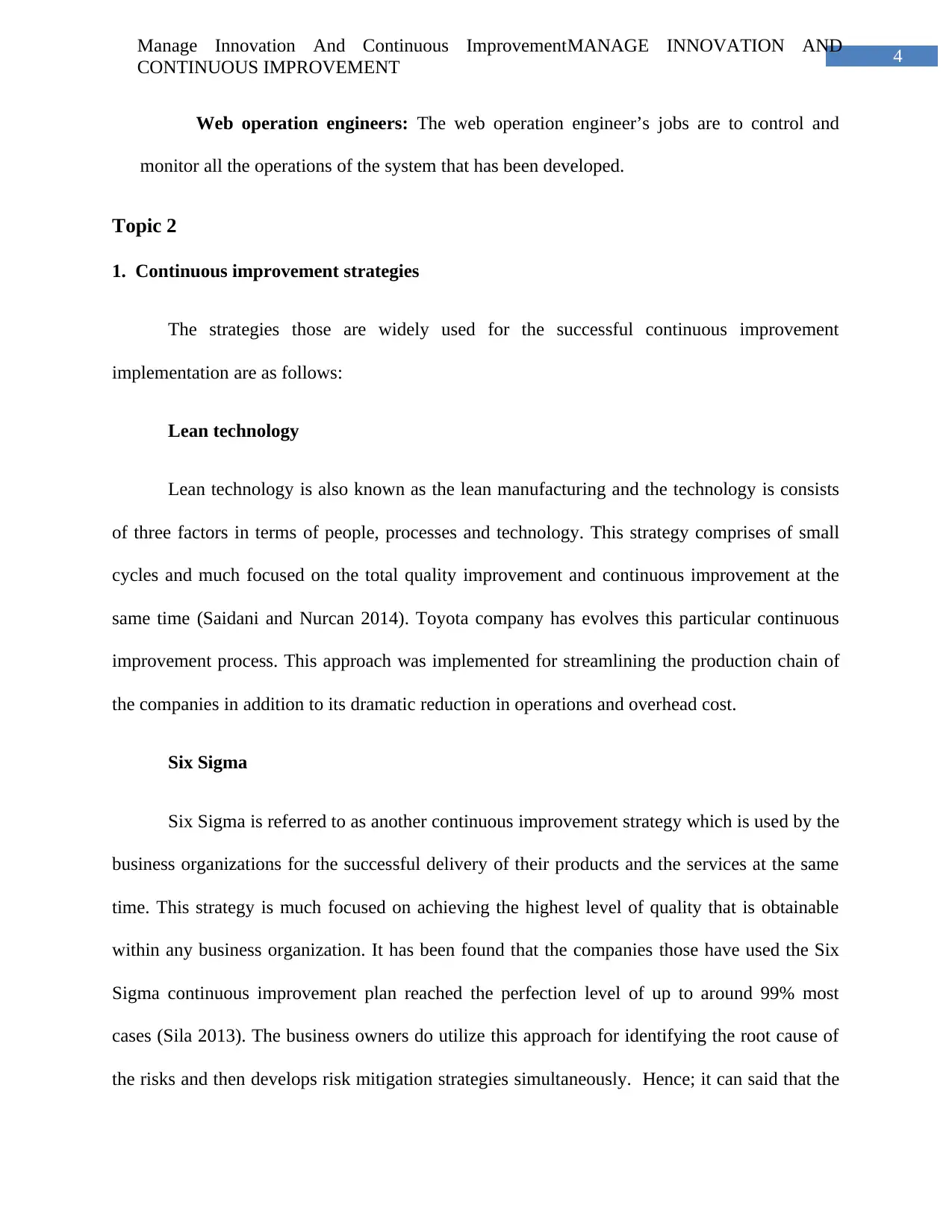
4
Manage Innovation And Continuous ImprovementMANAGE INNOVATION AND
CONTINUOUS IMPROVEMENT
Web operation engineers: The web operation engineer’s jobs are to control and
monitor all the operations of the system that has been developed.
Topic 2
1. Continuous improvement strategies
The strategies those are widely used for the successful continuous improvement
implementation are as follows:
Lean technology
Lean technology is also known as the lean manufacturing and the technology is consists
of three factors in terms of people, processes and technology. This strategy comprises of small
cycles and much focused on the total quality improvement and continuous improvement at the
same time (Saidani and Nurcan 2014). Toyota company has evolves this particular continuous
improvement process. This approach was implemented for streamlining the production chain of
the companies in addition to its dramatic reduction in operations and overhead cost.
Six Sigma
Six Sigma is referred to as another continuous improvement strategy which is used by the
business organizations for the successful delivery of their products and the services at the same
time. This strategy is much focused on achieving the highest level of quality that is obtainable
within any business organization. It has been found that the companies those have used the Six
Sigma continuous improvement plan reached the perfection level of up to around 99% most
cases (Sila 2013). The business owners do utilize this approach for identifying the root cause of
the risks and then develops risk mitigation strategies simultaneously. Hence; it can said that the
Manage Innovation And Continuous ImprovementMANAGE INNOVATION AND
CONTINUOUS IMPROVEMENT
Web operation engineers: The web operation engineer’s jobs are to control and
monitor all the operations of the system that has been developed.
Topic 2
1. Continuous improvement strategies
The strategies those are widely used for the successful continuous improvement
implementation are as follows:
Lean technology
Lean technology is also known as the lean manufacturing and the technology is consists
of three factors in terms of people, processes and technology. This strategy comprises of small
cycles and much focused on the total quality improvement and continuous improvement at the
same time (Saidani and Nurcan 2014). Toyota company has evolves this particular continuous
improvement process. This approach was implemented for streamlining the production chain of
the companies in addition to its dramatic reduction in operations and overhead cost.
Six Sigma
Six Sigma is referred to as another continuous improvement strategy which is used by the
business organizations for the successful delivery of their products and the services at the same
time. This strategy is much focused on achieving the highest level of quality that is obtainable
within any business organization. It has been found that the companies those have used the Six
Sigma continuous improvement plan reached the perfection level of up to around 99% most
cases (Sila 2013). The business owners do utilize this approach for identifying the root cause of
the risks and then develops risk mitigation strategies simultaneously. Hence; it can said that the
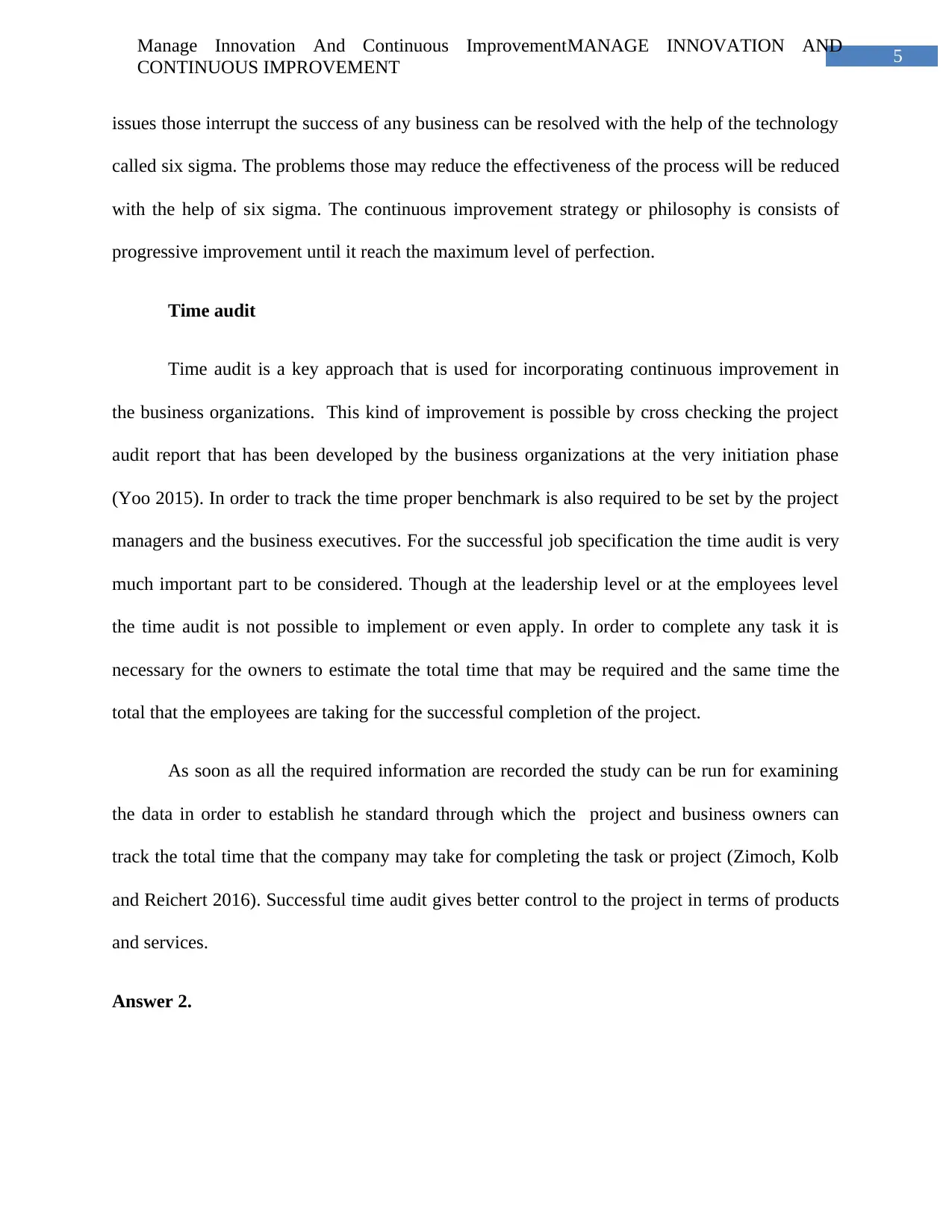
5
Manage Innovation And Continuous ImprovementMANAGE INNOVATION AND
CONTINUOUS IMPROVEMENT
issues those interrupt the success of any business can be resolved with the help of the technology
called six sigma. The problems those may reduce the effectiveness of the process will be reduced
with the help of six sigma. The continuous improvement strategy or philosophy is consists of
progressive improvement until it reach the maximum level of perfection.
Time audit
Time audit is a key approach that is used for incorporating continuous improvement in
the business organizations. This kind of improvement is possible by cross checking the project
audit report that has been developed by the business organizations at the very initiation phase
(Yoo 2015). In order to track the time proper benchmark is also required to be set by the project
managers and the business executives. For the successful job specification the time audit is very
much important part to be considered. Though at the leadership level or at the employees level
the time audit is not possible to implement or even apply. In order to complete any task it is
necessary for the owners to estimate the total time that may be required and the same time the
total that the employees are taking for the successful completion of the project.
As soon as all the required information are recorded the study can be run for examining
the data in order to establish he standard through which the project and business owners can
track the total time that the company may take for completing the task or project (Zimoch, Kolb
and Reichert 2016). Successful time audit gives better control to the project in terms of products
and services.
Answer 2.
Manage Innovation And Continuous ImprovementMANAGE INNOVATION AND
CONTINUOUS IMPROVEMENT
issues those interrupt the success of any business can be resolved with the help of the technology
called six sigma. The problems those may reduce the effectiveness of the process will be reduced
with the help of six sigma. The continuous improvement strategy or philosophy is consists of
progressive improvement until it reach the maximum level of perfection.
Time audit
Time audit is a key approach that is used for incorporating continuous improvement in
the business organizations. This kind of improvement is possible by cross checking the project
audit report that has been developed by the business organizations at the very initiation phase
(Yoo 2015). In order to track the time proper benchmark is also required to be set by the project
managers and the business executives. For the successful job specification the time audit is very
much important part to be considered. Though at the leadership level or at the employees level
the time audit is not possible to implement or even apply. In order to complete any task it is
necessary for the owners to estimate the total time that may be required and the same time the
total that the employees are taking for the successful completion of the project.
As soon as all the required information are recorded the study can be run for examining
the data in order to establish he standard through which the project and business owners can
track the total time that the company may take for completing the task or project (Zimoch, Kolb
and Reichert 2016). Successful time audit gives better control to the project in terms of products
and services.
Answer 2.
⊘ This is a preview!⊘
Do you want full access?
Subscribe today to unlock all pages.

Trusted by 1+ million students worldwide
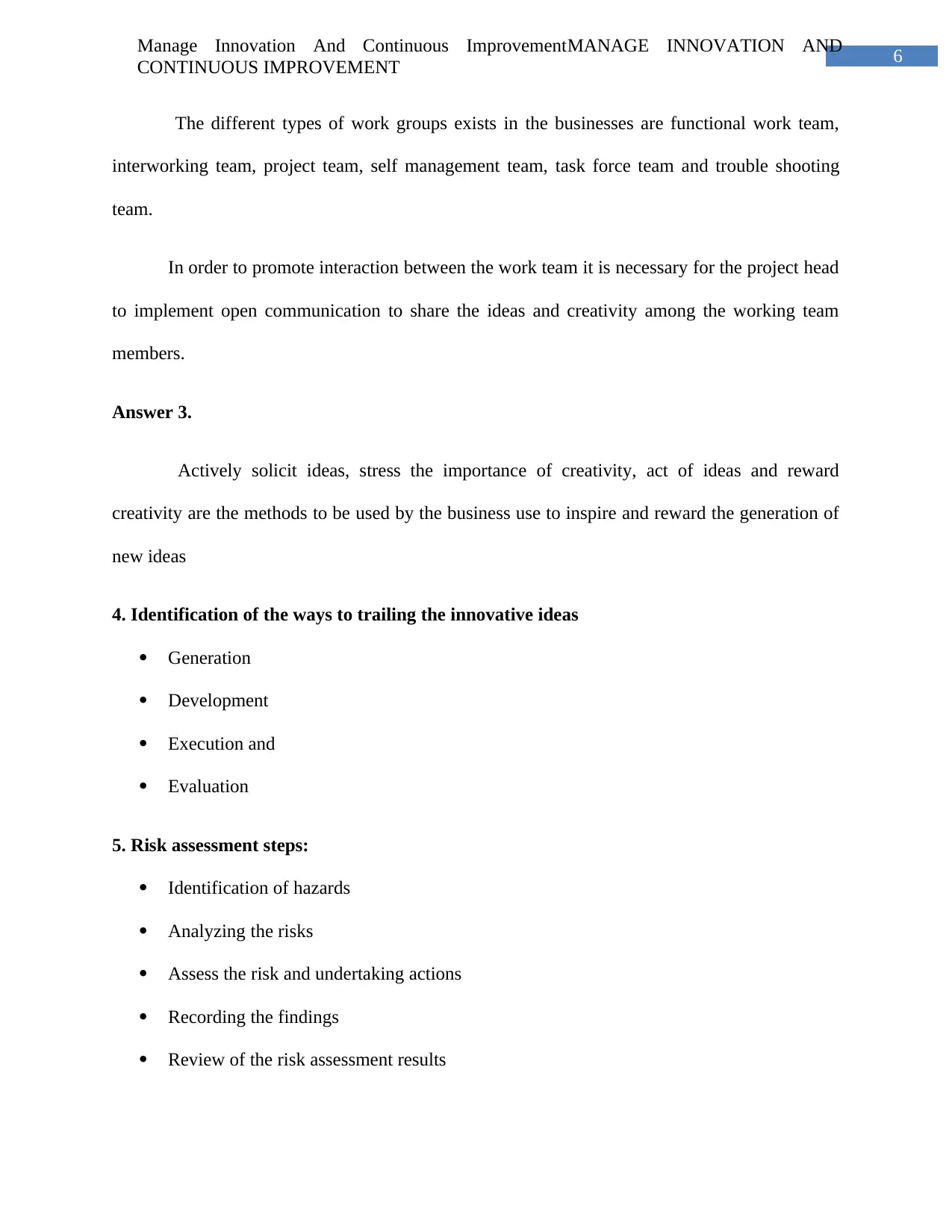
6
Manage Innovation And Continuous ImprovementMANAGE INNOVATION AND
CONTINUOUS IMPROVEMENT
The different types of work groups exists in the businesses are functional work team,
interworking team, project team, self management team, task force team and trouble shooting
team.
In order to promote interaction between the work team it is necessary for the project head
to implement open communication to share the ideas and creativity among the working team
members.
Answer 3.
Actively solicit ideas, stress the importance of creativity, act of ideas and reward
creativity are the methods to be used by the business use to inspire and reward the generation of
new ideas
4. Identification of the ways to trailing the innovative ideas
Generation
Development
Execution and
Evaluation
5. Risk assessment steps:
Identification of hazards
Analyzing the risks
Assess the risk and undertaking actions
Recording the findings
Review of the risk assessment results
Manage Innovation And Continuous ImprovementMANAGE INNOVATION AND
CONTINUOUS IMPROVEMENT
The different types of work groups exists in the businesses are functional work team,
interworking team, project team, self management team, task force team and trouble shooting
team.
In order to promote interaction between the work team it is necessary for the project head
to implement open communication to share the ideas and creativity among the working team
members.
Answer 3.
Actively solicit ideas, stress the importance of creativity, act of ideas and reward
creativity are the methods to be used by the business use to inspire and reward the generation of
new ideas
4. Identification of the ways to trailing the innovative ideas
Generation
Development
Execution and
Evaluation
5. Risk assessment steps:
Identification of hazards
Analyzing the risks
Assess the risk and undertaking actions
Recording the findings
Review of the risk assessment results
Paraphrase This Document
Need a fresh take? Get an instant paraphrase of this document with our AI Paraphraser
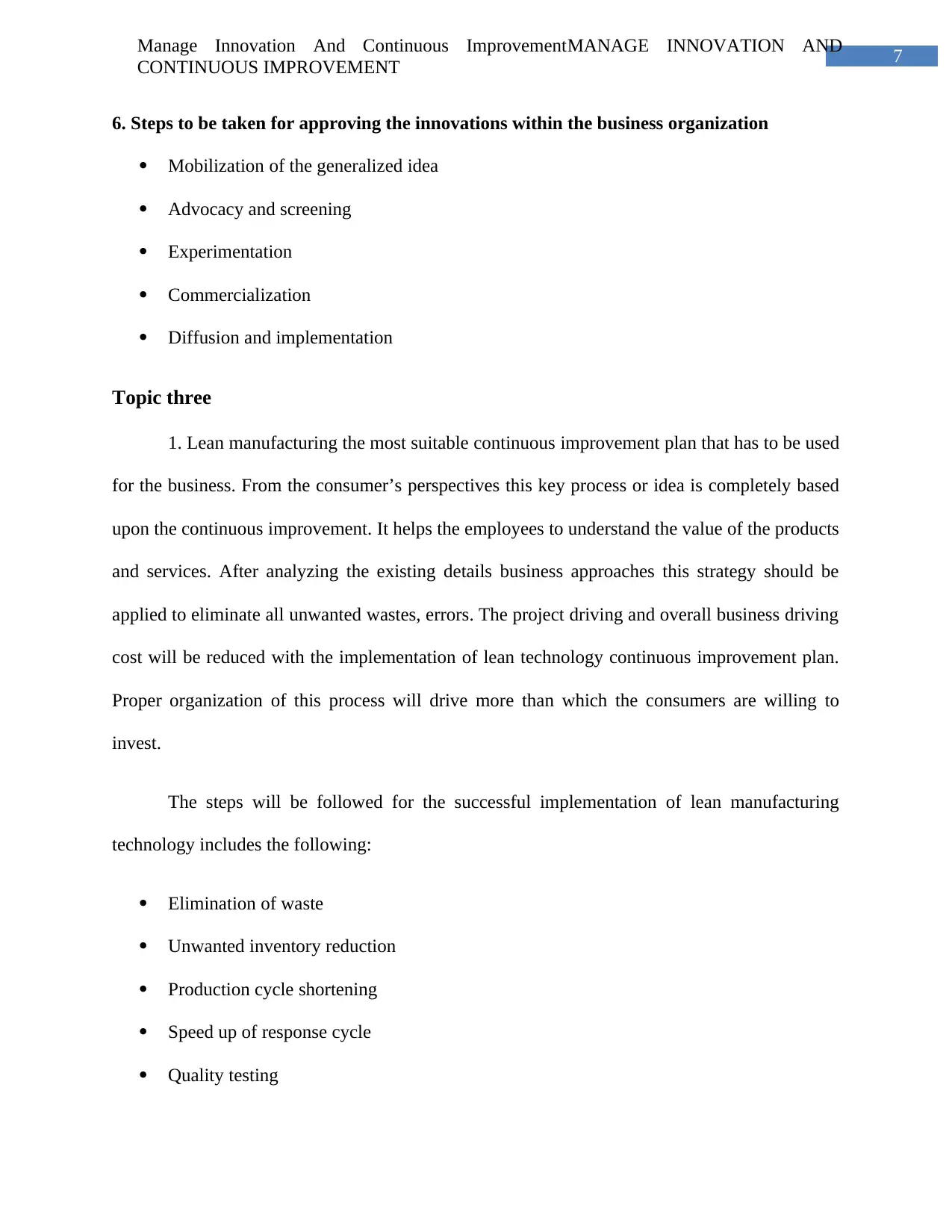
7
Manage Innovation And Continuous ImprovementMANAGE INNOVATION AND
CONTINUOUS IMPROVEMENT
6. Steps to be taken for approving the innovations within the business organization
Mobilization of the generalized idea
Advocacy and screening
Experimentation
Commercialization
Diffusion and implementation
Topic three
1. Lean manufacturing the most suitable continuous improvement plan that has to be used
for the business. From the consumer’s perspectives this key process or idea is completely based
upon the continuous improvement. It helps the employees to understand the value of the products
and services. After analyzing the existing details business approaches this strategy should be
applied to eliminate all unwanted wastes, errors. The project driving and overall business driving
cost will be reduced with the implementation of lean technology continuous improvement plan.
Proper organization of this process will drive more than which the consumers are willing to
invest.
The steps will be followed for the successful implementation of lean manufacturing
technology includes the following:
Elimination of waste
Unwanted inventory reduction
Production cycle shortening
Speed up of response cycle
Quality testing
Manage Innovation And Continuous ImprovementMANAGE INNOVATION AND
CONTINUOUS IMPROVEMENT
6. Steps to be taken for approving the innovations within the business organization
Mobilization of the generalized idea
Advocacy and screening
Experimentation
Commercialization
Diffusion and implementation
Topic three
1. Lean manufacturing the most suitable continuous improvement plan that has to be used
for the business. From the consumer’s perspectives this key process or idea is completely based
upon the continuous improvement. It helps the employees to understand the value of the products
and services. After analyzing the existing details business approaches this strategy should be
applied to eliminate all unwanted wastes, errors. The project driving and overall business driving
cost will be reduced with the implementation of lean technology continuous improvement plan.
Proper organization of this process will drive more than which the consumers are willing to
invest.
The steps will be followed for the successful implementation of lean manufacturing
technology includes the following:
Elimination of waste
Unwanted inventory reduction
Production cycle shortening
Speed up of response cycle
Quality testing
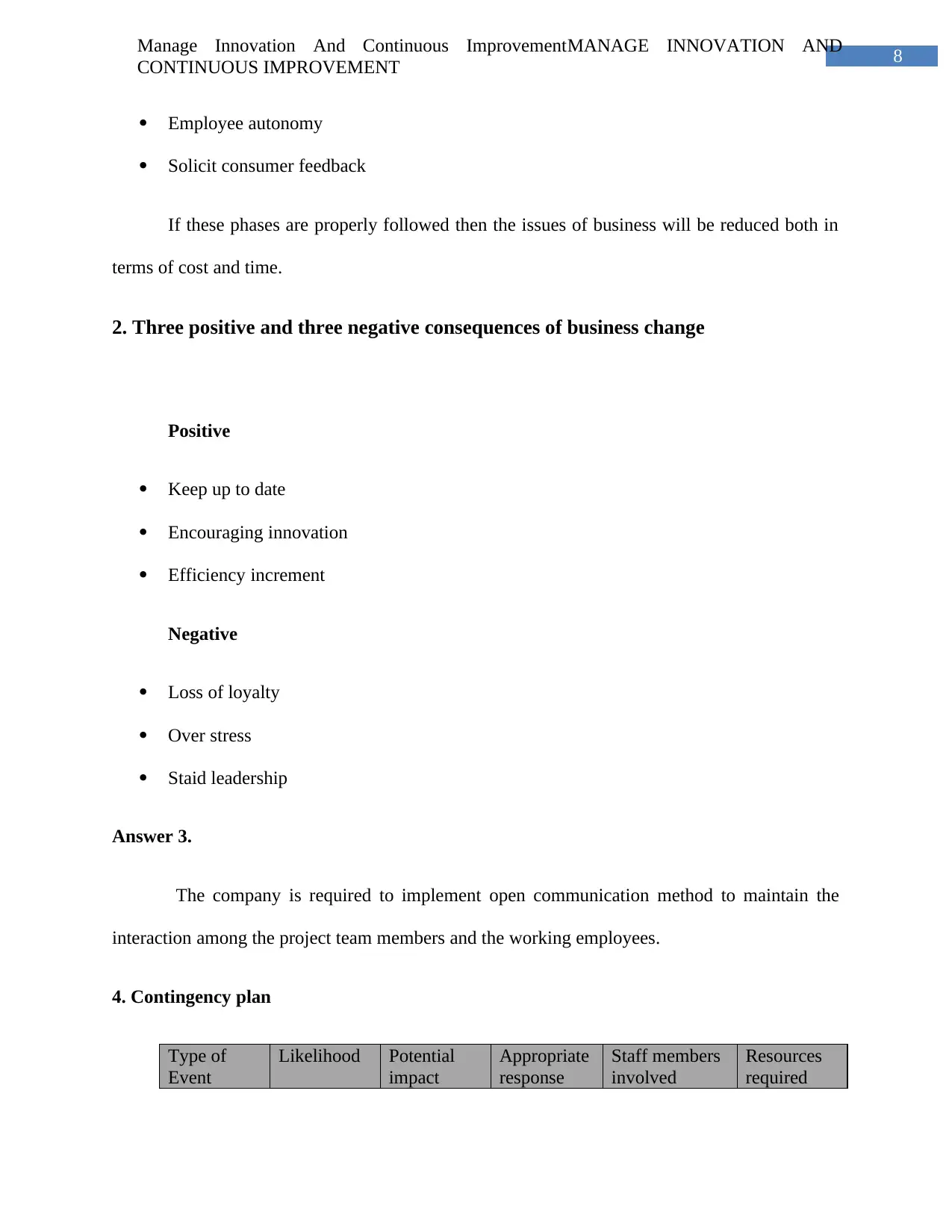
8
Manage Innovation And Continuous ImprovementMANAGE INNOVATION AND
CONTINUOUS IMPROVEMENT
Employee autonomy
Solicit consumer feedback
If these phases are properly followed then the issues of business will be reduced both in
terms of cost and time.
2. Three positive and three negative consequences of business change
Positive
Keep up to date
Encouraging innovation
Efficiency increment
Negative
Loss of loyalty
Over stress
Staid leadership
Answer 3.
The company is required to implement open communication method to maintain the
interaction among the project team members and the working employees.
4. Contingency plan
Type of
Event
Likelihood Potential
impact
Appropriate
response
Staff members
involved
Resources
required
Manage Innovation And Continuous ImprovementMANAGE INNOVATION AND
CONTINUOUS IMPROVEMENT
Employee autonomy
Solicit consumer feedback
If these phases are properly followed then the issues of business will be reduced both in
terms of cost and time.
2. Three positive and three negative consequences of business change
Positive
Keep up to date
Encouraging innovation
Efficiency increment
Negative
Loss of loyalty
Over stress
Staid leadership
Answer 3.
The company is required to implement open communication method to maintain the
interaction among the project team members and the working employees.
4. Contingency plan
Type of
Event
Likelihood Potential
impact
Appropriate
response
Staff members
involved
Resources
required
⊘ This is a preview!⊘
Do you want full access?
Subscribe today to unlock all pages.

Trusted by 1+ million students worldwide
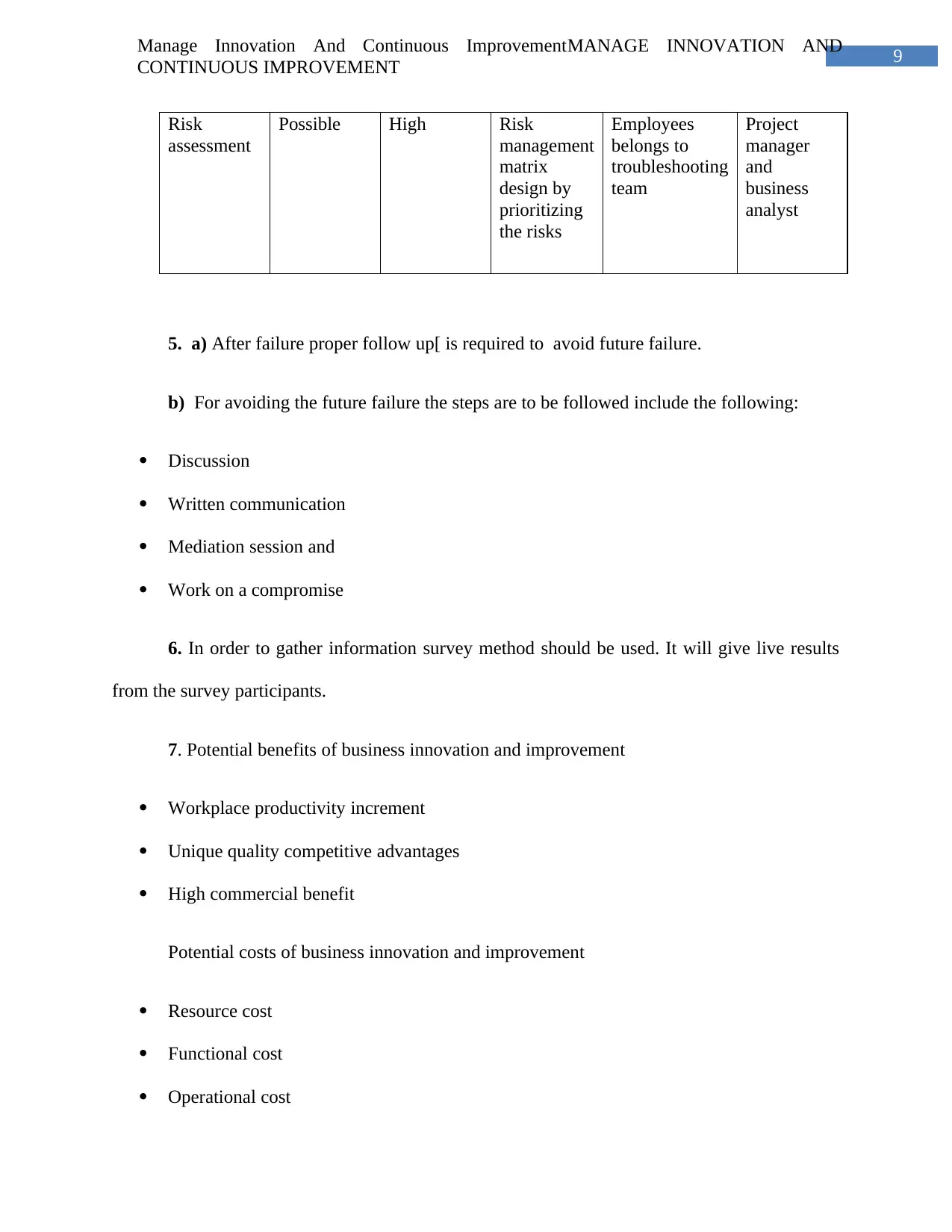
9
Manage Innovation And Continuous ImprovementMANAGE INNOVATION AND
CONTINUOUS IMPROVEMENT
Risk
assessment
Possible High Risk
management
matrix
design by
prioritizing
the risks
Employees
belongs to
troubleshooting
team
Project
manager
and
business
analyst
5. a) After failure proper follow up[ is required to avoid future failure.
b) For avoiding the future failure the steps are to be followed include the following:
Discussion
Written communication
Mediation session and
Work on a compromise
6. In order to gather information survey method should be used. It will give live results
from the survey participants.
7. Potential benefits of business innovation and improvement
Workplace productivity increment
Unique quality competitive advantages
High commercial benefit
Potential costs of business innovation and improvement
Resource cost
Functional cost
Operational cost
Manage Innovation And Continuous ImprovementMANAGE INNOVATION AND
CONTINUOUS IMPROVEMENT
Risk
assessment
Possible High Risk
management
matrix
design by
prioritizing
the risks
Employees
belongs to
troubleshooting
team
Project
manager
and
business
analyst
5. a) After failure proper follow up[ is required to avoid future failure.
b) For avoiding the future failure the steps are to be followed include the following:
Discussion
Written communication
Mediation session and
Work on a compromise
6. In order to gather information survey method should be used. It will give live results
from the survey participants.
7. Potential benefits of business innovation and improvement
Workplace productivity increment
Unique quality competitive advantages
High commercial benefit
Potential costs of business innovation and improvement
Resource cost
Functional cost
Operational cost
Paraphrase This Document
Need a fresh take? Get an instant paraphrase of this document with our AI Paraphraser
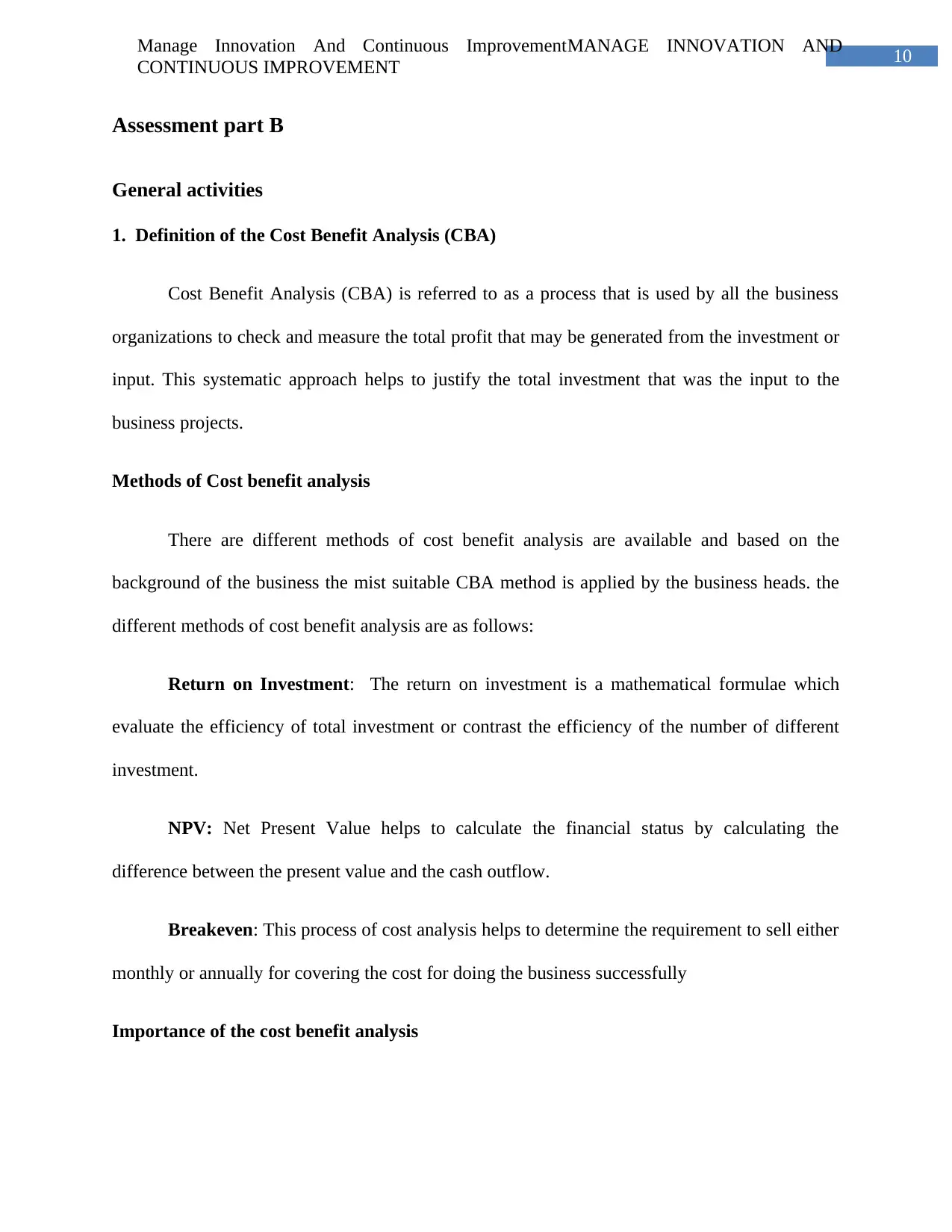
10
Manage Innovation And Continuous ImprovementMANAGE INNOVATION AND
CONTINUOUS IMPROVEMENT
Assessment part B
General activities
1. Definition of the Cost Benefit Analysis (CBA)
Cost Benefit Analysis (CBA) is referred to as a process that is used by all the business
organizations to check and measure the total profit that may be generated from the investment or
input. This systematic approach helps to justify the total investment that was the input to the
business projects.
Methods of Cost benefit analysis
There are different methods of cost benefit analysis are available and based on the
background of the business the mist suitable CBA method is applied by the business heads. the
different methods of cost benefit analysis are as follows:
Return on Investment: The return on investment is a mathematical formulae which
evaluate the efficiency of total investment or contrast the efficiency of the number of different
investment.
NPV: Net Present Value helps to calculate the financial status by calculating the
difference between the present value and the cash outflow.
Breakeven: This process of cost analysis helps to determine the requirement to sell either
monthly or annually for covering the cost for doing the business successfully
Importance of the cost benefit analysis
Manage Innovation And Continuous ImprovementMANAGE INNOVATION AND
CONTINUOUS IMPROVEMENT
Assessment part B
General activities
1. Definition of the Cost Benefit Analysis (CBA)
Cost Benefit Analysis (CBA) is referred to as a process that is used by all the business
organizations to check and measure the total profit that may be generated from the investment or
input. This systematic approach helps to justify the total investment that was the input to the
business projects.
Methods of Cost benefit analysis
There are different methods of cost benefit analysis are available and based on the
background of the business the mist suitable CBA method is applied by the business heads. the
different methods of cost benefit analysis are as follows:
Return on Investment: The return on investment is a mathematical formulae which
evaluate the efficiency of total investment or contrast the efficiency of the number of different
investment.
NPV: Net Present Value helps to calculate the financial status by calculating the
difference between the present value and the cash outflow.
Breakeven: This process of cost analysis helps to determine the requirement to sell either
monthly or annually for covering the cost for doing the business successfully
Importance of the cost benefit analysis
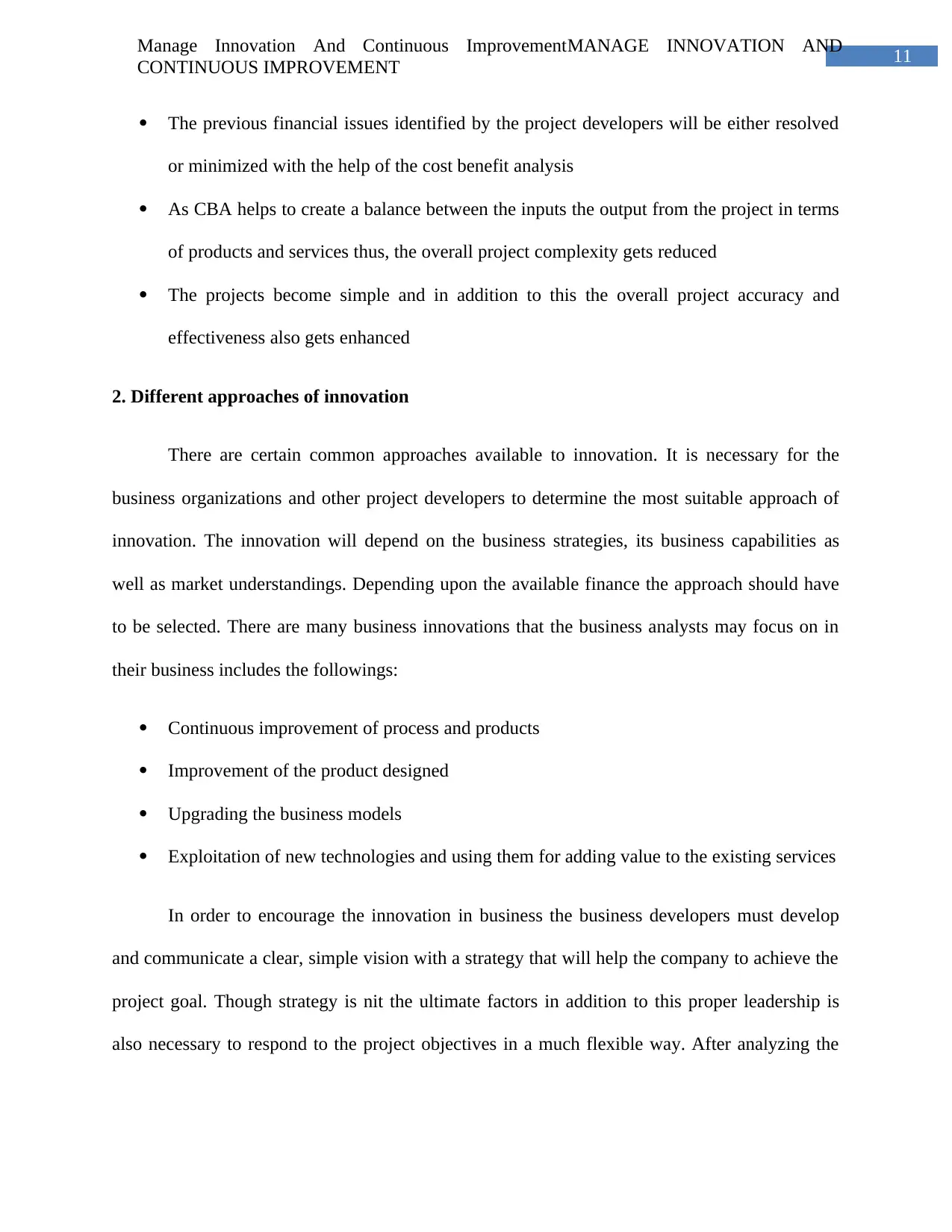
11
Manage Innovation And Continuous ImprovementMANAGE INNOVATION AND
CONTINUOUS IMPROVEMENT
The previous financial issues identified by the project developers will be either resolved
or minimized with the help of the cost benefit analysis
As CBA helps to create a balance between the inputs the output from the project in terms
of products and services thus, the overall project complexity gets reduced
The projects become simple and in addition to this the overall project accuracy and
effectiveness also gets enhanced
2. Different approaches of innovation
There are certain common approaches available to innovation. It is necessary for the
business organizations and other project developers to determine the most suitable approach of
innovation. The innovation will depend on the business strategies, its business capabilities as
well as market understandings. Depending upon the available finance the approach should have
to be selected. There are many business innovations that the business analysts may focus on in
their business includes the followings:
Continuous improvement of process and products
Improvement of the product designed
Upgrading the business models
Exploitation of new technologies and using them for adding value to the existing services
In order to encourage the innovation in business the business developers must develop
and communicate a clear, simple vision with a strategy that will help the company to achieve the
project goal. Though strategy is nit the ultimate factors in addition to this proper leadership is
also necessary to respond to the project objectives in a much flexible way. After analyzing the
Manage Innovation And Continuous ImprovementMANAGE INNOVATION AND
CONTINUOUS IMPROVEMENT
The previous financial issues identified by the project developers will be either resolved
or minimized with the help of the cost benefit analysis
As CBA helps to create a balance between the inputs the output from the project in terms
of products and services thus, the overall project complexity gets reduced
The projects become simple and in addition to this the overall project accuracy and
effectiveness also gets enhanced
2. Different approaches of innovation
There are certain common approaches available to innovation. It is necessary for the
business organizations and other project developers to determine the most suitable approach of
innovation. The innovation will depend on the business strategies, its business capabilities as
well as market understandings. Depending upon the available finance the approach should have
to be selected. There are many business innovations that the business analysts may focus on in
their business includes the followings:
Continuous improvement of process and products
Improvement of the product designed
Upgrading the business models
Exploitation of new technologies and using them for adding value to the existing services
In order to encourage the innovation in business the business developers must develop
and communicate a clear, simple vision with a strategy that will help the company to achieve the
project goal. Though strategy is nit the ultimate factors in addition to this proper leadership is
also necessary to respond to the project objectives in a much flexible way. After analyzing the
⊘ This is a preview!⊘
Do you want full access?
Subscribe today to unlock all pages.

Trusted by 1+ million students worldwide
1 out of 27
Related Documents
Your All-in-One AI-Powered Toolkit for Academic Success.
+13062052269
info@desklib.com
Available 24*7 on WhatsApp / Email
![[object Object]](/_next/static/media/star-bottom.7253800d.svg)
Unlock your academic potential
Copyright © 2020–2025 A2Z Services. All Rights Reserved. Developed and managed by ZUCOL.



